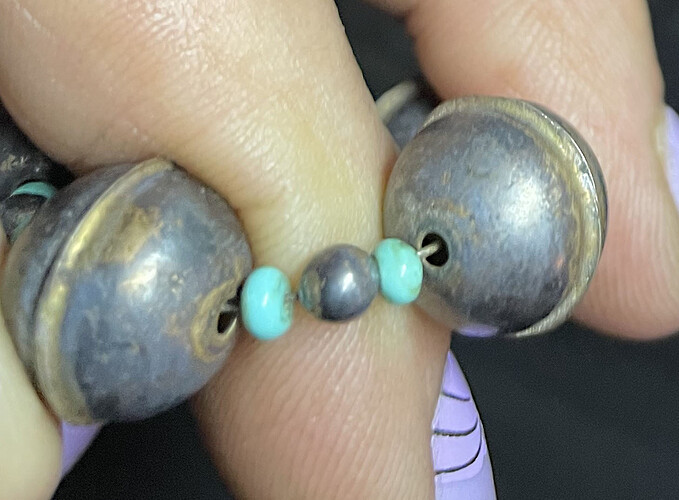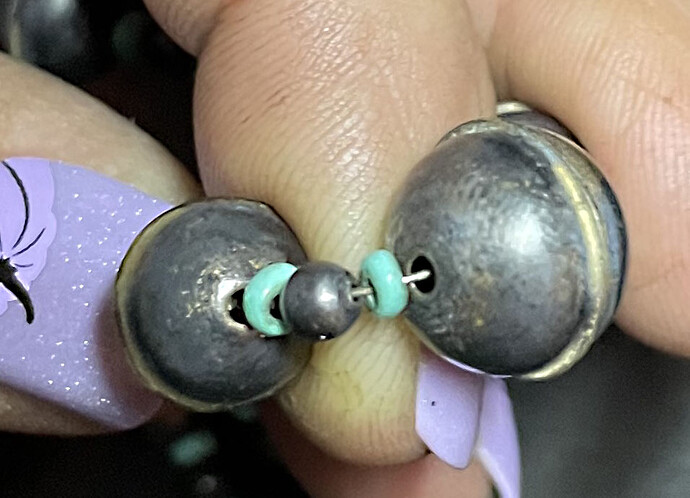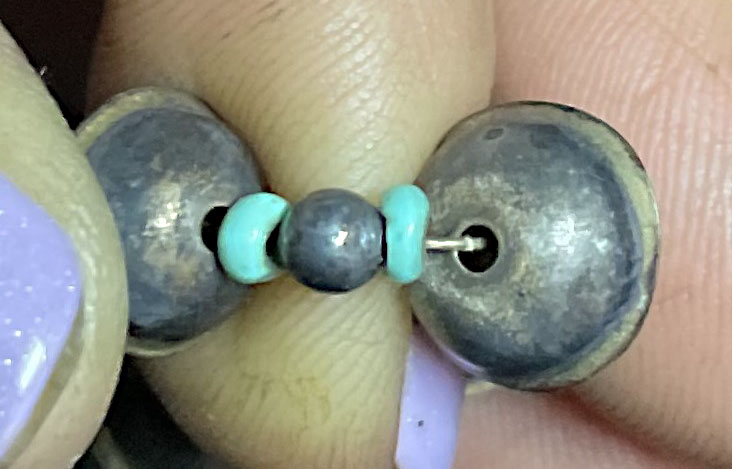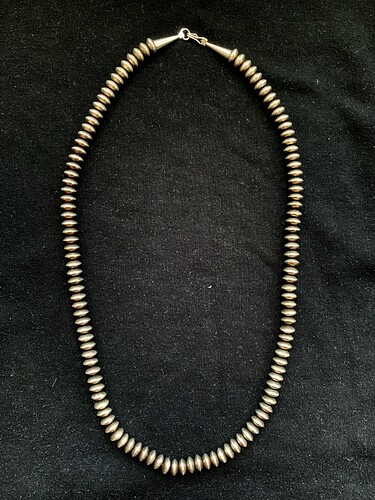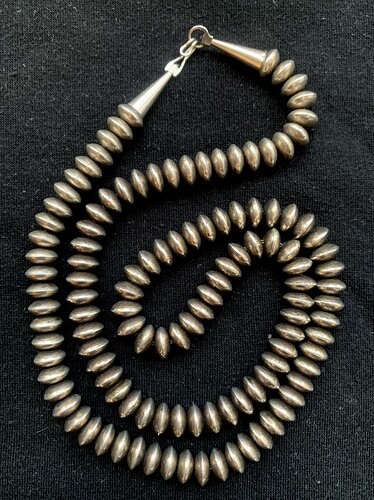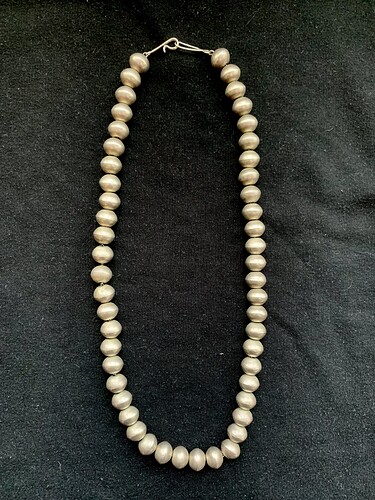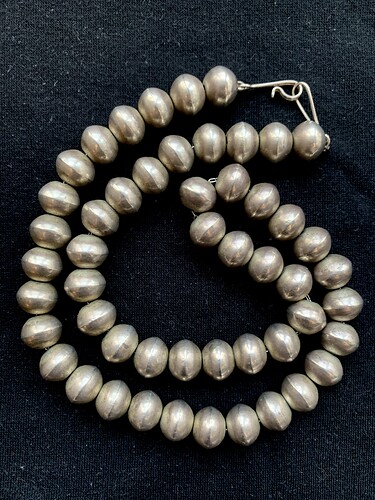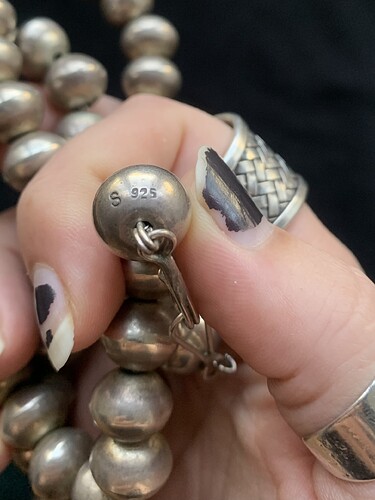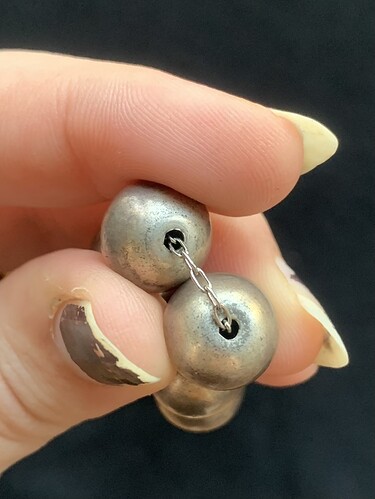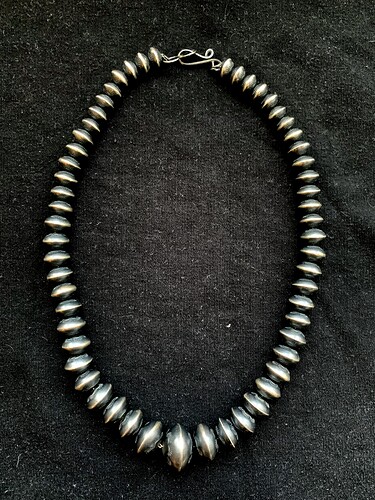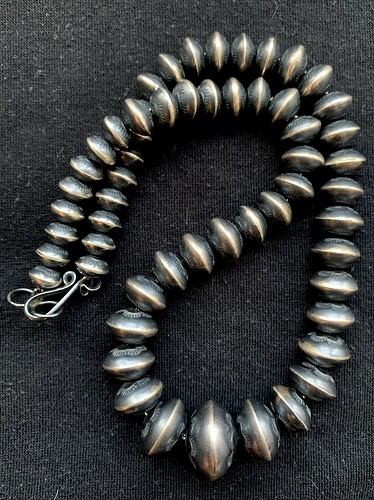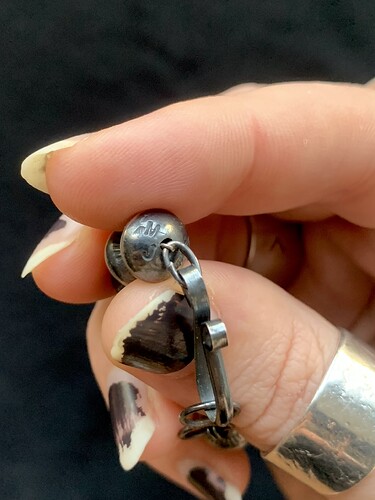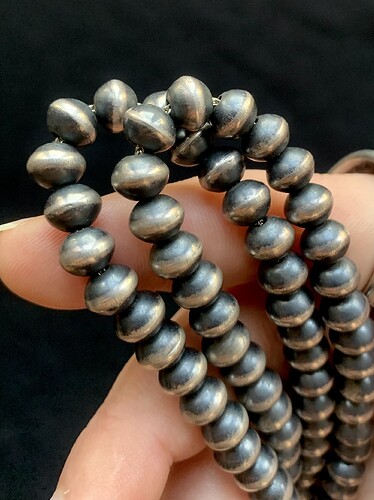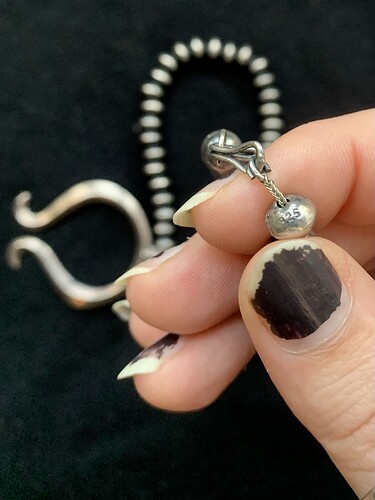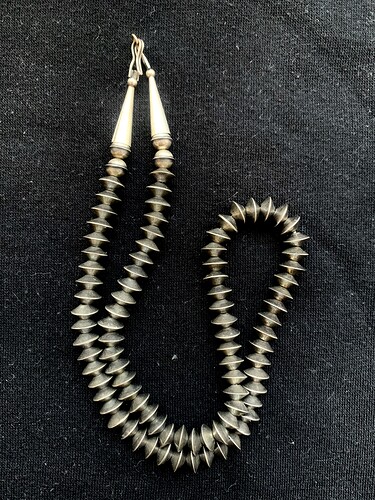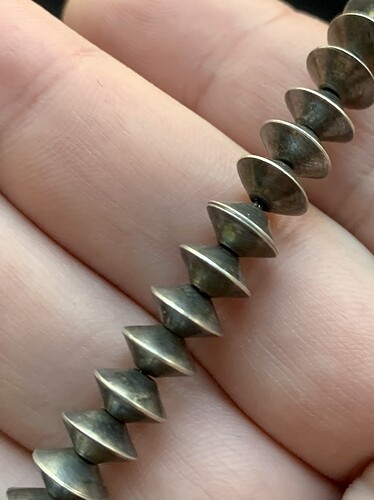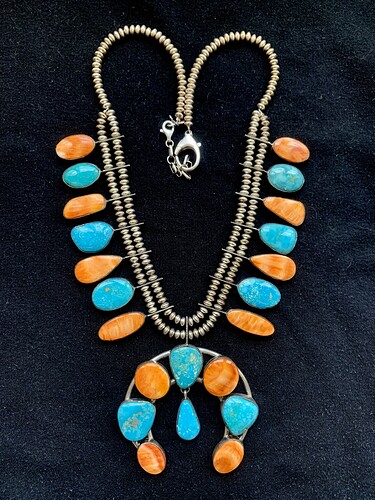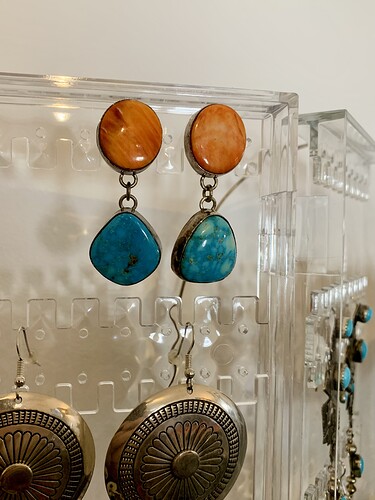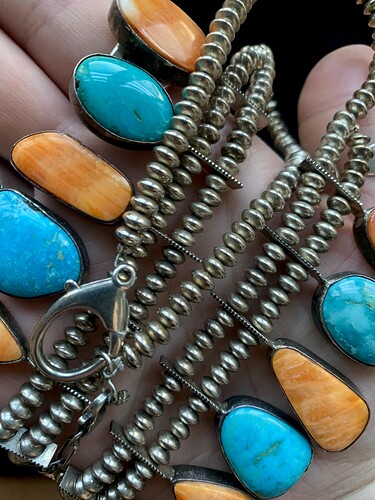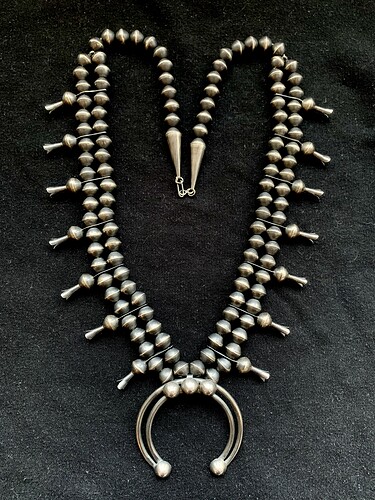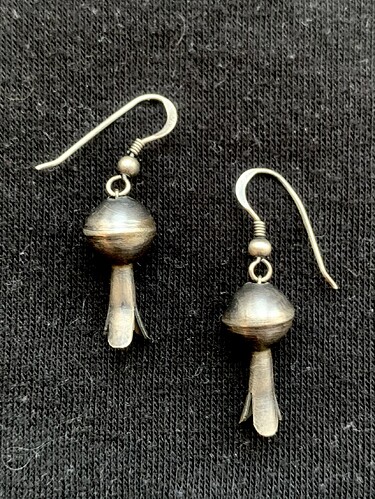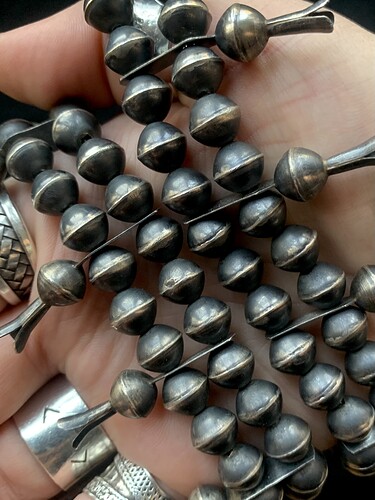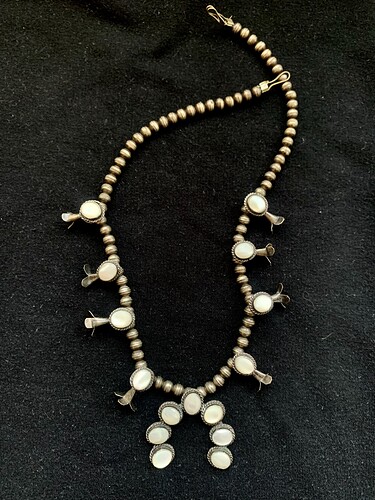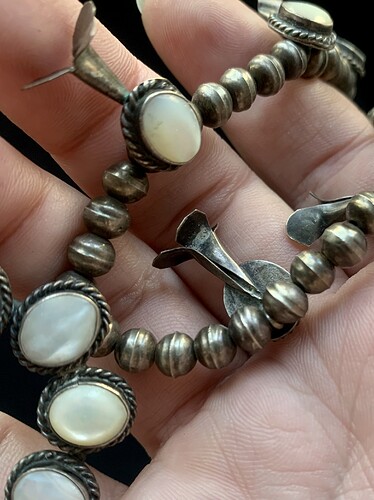The ones in a bag are the Turquoise. I don’t have any more of the silver ones.
Thank you. I was spoiled living in AZ and having access to nice materials.
Here are some close photos of the beads showing solder areas and holes. The necklace is strung pretty tight.
Thank you, Fernwood. The halves definitely look die punched.
Thank you. The soldering is messy. Some of the beads have small gaps between the sides.
Looks like paste solder was used, probably #56 from the color. Things can move around a bit when the flux bubbles up during heating to melting temp.
@mmrogers So, this prompts a question. I’ve seen some beads like this in necklaces that are set askew, the halves are not aligned. Is this an outcome of what you described in your comment about soldering? Thanks for your help!
Hi Patina. Misalignment can occur mechanically (things just get put together a bit crooked) or can occur during the soldering process. As the pieces heat up to the boiling point of the water or oily binders in the flux, bubbling can occur and this can physically move pieces around. Also, flux gets slippery when it gets close to the melting temp of the solder, and the pieces being soldered can slip around a bit within the molten flux. This is why you almost always see a silversmith working with a torch in one hand and a long solder pic in the other. The solder pic is used to keep parts in alignment, and wrangle them back into alignment when they start slipping around at 1,200 degrees.
Hi @mmrogers ~ Thanks so much for taking time to explain this process. I appreciate your clear and concise explanation. It helped me to understand how beads can sometimes end up misaligned. I had no idea such high temps are invloved in jewelry making! I also learned new words like flux & solder picks. Learning is a good thing.
uh…be careful how you pronounce the new vocabulary ![]()
Hi all! I’m glad I found this thread before starting a new one, which I understand to be a faux pas. Silver beads remain really mysterious to me, though I’ve tried to educate my eye and read up as much as I can. I’m hoping that some of the experts here might be able to offer some thoughts on how correct (or incorrect) I am in assessing my own collection. Buckle up, because I have eight separate pieces here! I completely understand if this is too exhausting for anyone’s patience, though I figured that—in general—more examples to look at are usually a good thing on this forum. ![]()
I’ll include a photograph laid as each item would appear worn, another a bit bunched up (since this seems to show more detail), any hallmarks or purity marks, and any relevant “details.” Disclaimer: I took these photos in indirect sunlight in front of my window, so the lighting is sort of all over the place; please also excuse my horrifyingly chipped nail polish. ![]()
1: These are my favorite, a longer strand of saucer-shaped beads by Raymond Tso. I had lost a much shorter strand by the same artist and bought these as a replacement but have grown to love them more than the original strand! They are strung on foxtail and have Tso’s hallmark on the cone beads. I don’t have any questions about these and know them to be handmade, so they are the benchmark I assess other beads by (at the moment).
2: This is a strand I was always on-the-fence about, authenticity-wise, as while evidently handmade beads (and quite heavy) they are hallmarked “925,” which I know to be extremely rare in the world of NA jewelry. I had them examined at a reputable gallery in Tucson about five years ago and they determined that they are, in their opinion, handmade beads and that if they listed them for sale they would be confident calling them “1980s, likely Navajo,” based on their quality (and because without a hallmark or firmer provenance, it is, of course, illegal to claim them as Native-made). They also explained that, at times (and in their experience), beads made commercially in the 1980s can bear a 925 stamp because: 1), the stamp is smaller and might better fit the bead than an artist’s usual “Sterling” stamp; 2), there were market pressures in the 1980s that led consumers to more readily identify and look for the term “925”; and 3), in my case, the other hallmark—the “S”—may be a maker’s mark, in which case the artist may have wished to avoid confusion with the word “Sterling,” although that may be exactly what the “S” is referring to in the first place(?). (This last seems like a reach, but I include it for sake of argument.) Of these, I’m most persuaded by the second possibility. The strand is strung on a box chain and you can observe the variance in the drilled parts of the beads and a very slight “bulge” or lip running from the inside-out (this might be hard to make out in the picture), which I’ve been told is a clue toward hand manufacture. What do you think? Did the gallery (and I!) miss the mark here?
3: This is a graduated strand by the remarkably talented Michelle Jameson. The strand is hallmarked on the uppermost bead. I purchased because I wanted a shorter strand for layering, although I more often wear them on their own now because they sit perfectly in the gap between a t-shirt and my throat. They have been quite heavily antiqued, which is not my preferred “look,” but this has grown on me over time. Jameson strings her work on box chain. I noticed that the “bulge” around the hole isn’t present on her—inarguably handmade—beads; my assumption is that this has to do with the more exacting tools a contemporary silversmith utilizes. Thoughts on this?
4: These are beads that I am not comfortable calling Native American, though I waffle back and forth on the subject. (Ignore the background naja, which I’ve posted in another thread; it isn’t original to these beads—they were purchased separately.) The beads are quite heavy for their size, perhaps four times heavier than the machined strands I’ve seen in tourist shops. I believe them to be handmade, but remain unsure: they are marked “925” and seem to mirror too closely the taste for “banded” oxidation found in the more fashion-forward (and often not Native- or even Mexican-made) examples for sale online that list along the “Native-style” line. What do y’all think?
5: I’m 99% positive that this strand is bench-made. The beads are incredibly uniform, but hand-soldered. (The pronounced-but-clean seam is my clue.) They are very lightweight and strung on really good foxtail (which seems an odd choice for such inexpensive beads).
As squash blossoms generally incorporate beads of this sort, here are a few quick examples from my collection, focusing on the beads:
6: This squash (hallmarked for Mary Ann Spencer) was likely restrung on tiger tail or a similar lightweight wire (consider the lobster clasp, LOL) and I am on the fence about whether the beads are handmade. For one, they are incredibly tiny and I’m not sure I’ve seen handmade beads this small; secondly, they are very uniform—though under a loupe I can see what appears to be a couple misaligned solder seams. Thoughts? I wear this squash quite often, as it’s fun and the turquoise (I think it’s Easter Blue, but wouldn’t swear to it) is gorgeous, but think about having it restrung with larger beads frequently. Sometimes I think the scale works better than I give it credit, so I’ve yet to source any new beads. The second photograph is a pair of earrings Spencer made to go with the necklace. The third picture is the least successful of my “zooms”: these beads simply do not want to be photographed!
7: This is a piece attributed to Gilbert Martin, though it is unsigned (but marked Sterling). I purchased it vintage from a seller who included her original receipt from Perry Null, so I feel confident in her attribution (and because it correlates with photographs of Martin’s work online, which also appear to be sometimes-unsigned). I wear this one very frequently, as I appreciate the simplicity in the line. It is strung on box chain. The beads are handmade: the solder is sometimes evident to the naked eye, the beads are not entirely uniform, and there is often a “jagged” or “bulged” lip near the hole, indicating that the beads have been drilled in the correct direction (from the inside-out, while not-yet-soldered, as I understand it). I don’t mind the antiquing here, though I sometimes wish it were shinier. The second photograph is the earrings made for the necklace and sold alongside it both at Perry Null and later when I bought it secondhand. Interestingly, while the squash is marked “Sterling” (twice!) the earrings are marked “925,” though this may be because the hooks for the earrings were purchased ready-made.
8: This last example is what I’m assuming to be a 1970s tourist-grade squash, though it was sold as 1950s. I actually bought it just for the naja, which I have thought about removing to wear separately as the scale of the necklace doesn’t work well for me (I’m taller) and the entire thing tends to migrate on my neck as it is so lightweight. It is strung on some sort of wire. The beads are clearly “bench beads,” as they appear to be hand-soldered but are definitely constructed from machine-made bead blanks. From what I understand, this is most evidently based on the pronounced seam that appears as a raised line.
How did I do? I look forward to any corrections of things I’ve misunderstood or missed entirely! I am—as ever—so grateful for the wealth of knowledge on this site. ![]()
You did great!! But I’m slightly annoyed, because now you have made me add Navajo beads to my yearly wishlist, and I already have more items on it than I can afford ![]() I only have 2, but I think I need at least one more string for layering, amirite?!
I only have 2, but I think I need at least one more string for layering, amirite?!
Seriously, love them all. The #2 beads look handmade to me, and I would guess the S is a hallmark. I love the soft patina, and they remind me of one of mine, although that strand of mine has no marks at all. Your #4 beads look a bit like my oxidized saucer pair which I know are handmade (bought directly from the artist), and yours also don’t seem to have the totally obvious line of oxidation that the non-native beads have - if that makes sense ![]()
I don’t have anything else to add, other than that I would agree with your assessment of your beads, but I’m certainly not an expert. My favorites are #2 and #3, but all are beautiful.
Also, it would not be a faux pas (even though I have a French last name that’s some of the only French I know, LOL) to have started a new thread; sometimes when members do, I just link them to an existing one if I can find it, because I figure they would like to know even more about the topic. I think the only time we get a bit frustrated is when a new member starts two threads quickly on an item, because they think we haven’t responded quickly enough to the initial post (sometimes they just realize they posted in the wrong topic and that’s understandable).
Thanks for posting your gorgeous beads!!
@raysha, I agree, they certainly look handmade to me!
@riobravo, you have a wonderful collection of beads, and your assessment seems to be right on from what I know about handmade vs bench made beads.
To me the specific characteristics I look for to determine if beads are hand made are 1.) the presence of a bit of a lip at the hole indicating each bead half was hand-punched from the inside out before soldering. I understand that this lip can be ground off, similar to what can be done to the center soldered connection, leaving it smooth. And 2.) the slight variation in the bead size, and shape, which can be difficult to notice in very well made beads. I’d love to hear other characteristics you more knowledgable folks use when assessing beads.
Check out the lovely c. 1930’s beads posted by @chicfarmer in “The Elusive Naja” topic recently posted. In my opinion these show characteristics of exceptionally well made handmade beads.
